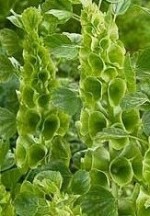 The apple green color and name, “ Bells of Ireland”, certainly suggest that this plant comes for Ireland but it doesn’t. It is an annual native of Turkey, Syria, and the Caucasus and has been cultivated since the sixteenth century. Peak supplies are from June to October but stems are available all year long so they can be used in St. Patrick Day arrangements where they will make a smashing impact.
The apple green color and name, “ Bells of Ireland”, certainly suggest that this plant comes for Ireland but it doesn’t. It is an annual native of Turkey, Syria, and the Caucasus and has been cultivated since the sixteenth century. Peak supplies are from June to October but stems are available all year long so they can be used in St. Patrick Day arrangements where they will make a smashing impact.
Bells of Ireland are a member of the mint family and so are related to Coleus, Swedish ivy, Salvia, basil, lavender, and, of course, mint. Like the other members of the family, Bells of Ireland have square hallow stems. The green bell shaped structures that appear to be flowers are actually calyces surrounding small inconspicuous white or pink flowers. The stems have small thorns that can cause allergic reactions or rashes and the leaves are prickly.
Buy bells of Ireland when the tiny flowers inside the calyces look fresh. Store them vertically until ready to use or they will curve in due to a geotropic response. When arranging the stems, be aware of this response since your design will change as the stem curves. Vase life is 7-10 days.
Bells of Ireland do well in a variety of arrangements. They provide a strong vertical accent in large arrangements and are striking in all-foliage designs or contemporary designs. Floral clusters can be cut from the stems and made into garlands or used in Euro-style designs and basing techniques. In the language of flowers, Bells of Ireland represent luck and can be used to send a message in a bouquet. Stems are also suitable for drying. After removing the leaves and thorns hang them upside down in a cool, dark, airy location.
